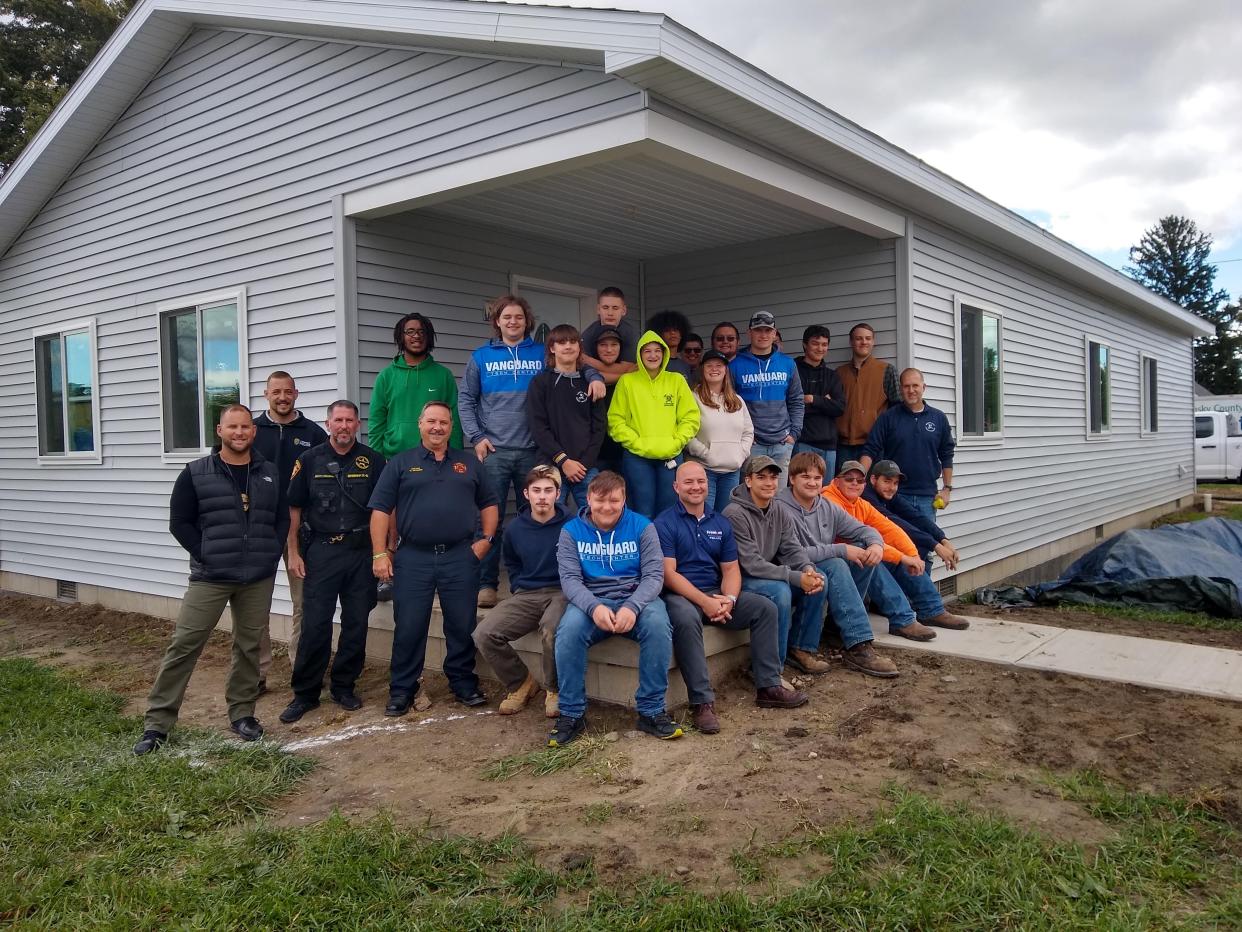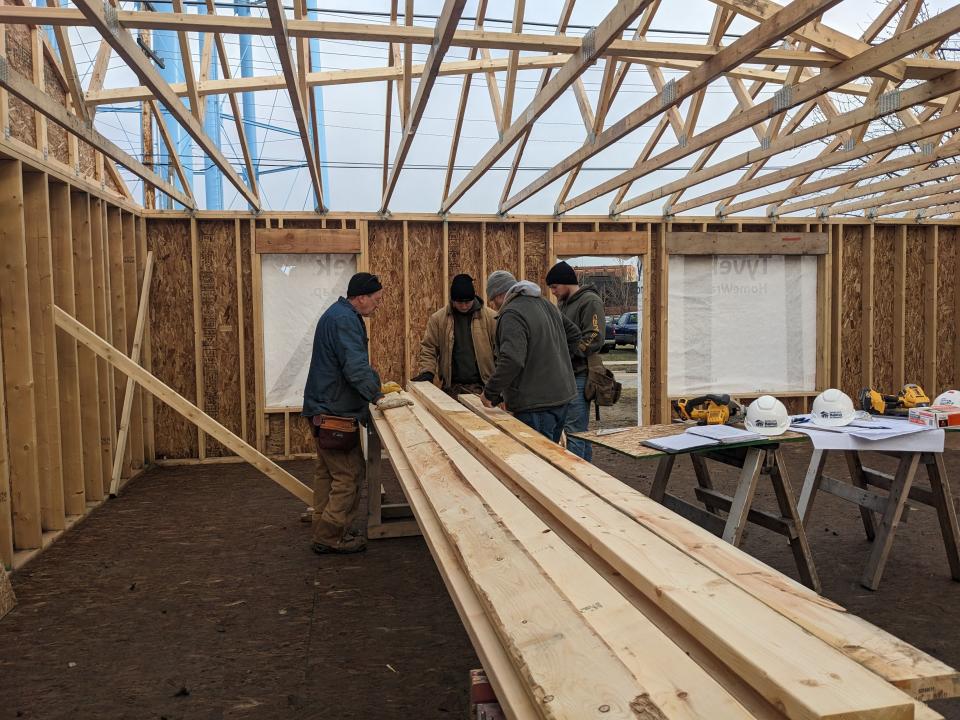Habitat for Humanity's new home on Quail Drive brings people together

FREMONT - Since 1976, Habitat for Humanity has been helping build, renovate, and repair homes and improve the lives of families worldwide.
The current local build on Quail Drive in Fremont will provide a home to a Fremont woman and her two children. It takes about a year to complete the process, and it is done with the help of the new homeowner’s family, friends, and many volunteers. Much of the support comes from donations from local families, businesses, and corporations. Of 1 million homes built by Habitat for Humanity, each house is the byproduct of thousands of hours of "sweat equity," volunteer labor, and teamwork.
One of Habitat for Humanity’s missions is to bring people together to build homes, within the community, in an effort to foster hope. So far, Habitat has helped more than 5 million people obtain affordable, sustainable housing.
“Nearly 100% of our homes are built with volunteers. We do utilize skilled labor contractors for items like the foundation, insulation, drywall, and HVAC/plumbing,” said Pam Kensler, executive director of Sandusky County Habitat for Humanity.
Everything, including the homeowner’s mortgage, goes back into the community. This is why homeowners must be able and willing to pay an affordable mortgage through the county’s Habitat for Humanity’s low-interest mortgage. Habitat mortgage payments cycle back into the community to help build additional Habitat houses.
Habitat for Humanity and the families that partner with them to build or improve homes come from various backgrounds and are selected at a local level. The recipients’ selection is based on the family’s need for better housing, their ability to pay an affordable mortgage, and their willingness to work alongside volunteers and put in their "sweat equity" hours.
“We have a selection committee that reviews all of our applications when we have an open enrollment period," Kensler said. "Currently we do an annual enrollment period based on the available lots for building in the coming year… Our program is centered on providing 'a hand up, not a hand out'."
"We determine the (type of) home that will be built based on the household size," Kensler said. Habitat also considers the "number of bedrooms needed to provide adequate sleeping space for everyone, we also look at the income level to ensure the home size is affordable well into the future for the homeowner.”

Each family must put in at least 200 hours of sweat equity, though the local communities board can determine a flexible meaning to the hours spent.
Sometimes that includes one hour of sweat equity for every A in school a child within the home earns. The families work alongside volunteers and donors to help build and renovate the places they will eventually call home. After their home is built, some families choose to continue to donate their time at their local Habitat ReStore, or resale shop, while others may serve on committees or help out in their local Habitat office.
Those residents are not forced to volunteer there but it's because they understand the value that Habitat for Humanity brings back to families and their communities.
“Sweat Equity has always been a part of the Habitat for Humanity program," Kensler said. "This is critical to a homeowner's willingness to partner and creates opportunities for the homeowner to learn how to maintain their home once they move in. It's also a great way for our other volunteers, sponsors and partners to meet the future homeowner and any children that will be moving into the home.”
Future homeowners must also attend financial education and budget-planning classes to help ensure the family has every resource available to continue their path toward success. "Habitat Learns" furthers this vision by educating everyone interested in learning more about housing issues around the world.
The learning portal has online courses, articles, and downloadable resources. These resources are free and available to anyone interested in learning. The topics in Habitat Learns range from construction basics to housing finance options to tips on bringing a Habitat for Humanity into your community.
One of the struggles Habitat for Humanity has recently encountered is finding environmentally safe and sustainable building supplies. According to the United Nations Environment Programme, they have found that buildings and their construction produce nearly 40% of global energy-related greenhouse gas emissions.
To help combat that, Habitat for Humanity says, “We believe that adequate and affordable housing can be built sustainably and will contribute to the achievement of the Sustainable Development Goals adopted by all of the United Nations member states in 2015 as part of the 2030 Agenda for Sustainable Development. By increasing the use of sustainable natural resources and construction practices while reducing the emission of greenhouse gases throughout a home’s life cycle.” This is one of the ways Habitat for Humanity leaves a longer-lasting legacy with every home built.
“Sandusky County Habitat for Humanity relies upon the generosity of the community to grow our mission and provide affordable homeownership opportunities to our future homeowners. A large source of that generosity is the volunteer time given, which allows us to keep our labor costs minimal. Any time we are able to lower our costs we are able to stretch our financial resources to serve another homeowner's family sooner,” said Kensler.
For anyone wondering what all goes into building a home and how it adds up, here’s a short list of some of the donated resources they’ve used in one year: 288 roofing systems from GAF; 9,190 privacy blinds from Hunter Douglas; 251,943 gallons of paint from Valspar; 42,914 locks from Yale; 100 football fields' worth of Styrofoam insulation from Dow; 63,402 Square D electrical products from Schneider Electric; and 11,152 refrigerators and ranges from Whirlpool Corporation.
“We are always open to more partnerships in our home projects. Partnerships such as the one we've developed with Vanguard's Building Trades Program allow us to work more efficiently and often times faster," said Kensler. "Any time we can engage the community and develop partnerships we are increasing the overall impact of our program which means more homeowners are able to experience the strength, stability and self-reliance that is possible through our homeownership program.”.
To learn more or to volunteer, or donate to Habitat for Humanity or the Quail Drive build, contact the local Habitat for Humanity branch at sanduskycountyhfh.org.
This article originally appeared on Fremont News-Messenger: Sandusky County Habitat for Humanity brings community together

